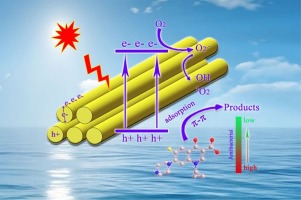Applied Catalysis B: Environment and Energy ( IF 20.2 ) Pub Date : 2018-01-11 , DOI: 10.1016/j.apcatb.2018.01.024 Fengliang Wang , Yiping Feng , Ping Chen , Yingfei Wang , Yuehan Su , Qianxin Zhang , Yongqin Zeng , Zhijie Xie , Haijin Liu , Yang Liu , Wenying Lv , Guoguang Liu

|
The occurrence of fluoroquinolones (FQs) in the ambient environment has raised serious concerns. In this study, the photocatalytic degradation kinetics and mechanism of ciprofloxacin (CIP) was investigated in ordered mesoporous g-C3N4 (ompg-C3N4). Under simulated sunlight irradiation, ompg-C3N4 exhibited a 2.9 fold more rapid reaction for CIP degradation than bulk g-C3N4. This enhancement may be attributed to the large specific surface area and effective charge separation of ompg-C3N4. The eradication of CIP followed the Langmuir–Hinshelwood (L–H) kinetics model, and surface reactions played a significant role during the photocatalysis process. Further study of reactive species (RSs) by both ESR technology and RSs scavenging experiments revealed that the superoxide anion radical (O2−) and photohole (h+) were primarily responsible for the degradation of CIP. Based on the identification of intermediates using liquid chromatography with tandem mass spectrometry (HPLC-MS/MS), and the prediction of reactive sites via Frontier Electron Densities (FEDs), the degradation pathways of CIP were proposed. A comparison of the degradation among FQs revealed that the piperazine moiety showed a dramatic effect on the degradation of FQs during the photocatalysis process. A residual antibiotic activity experiment revealed that ompg-C3N4 provided a very desirable performance for the reduction of antibiotic activity. The sufficient photocatalytic degradation of CIP in ambient water revealed that a sunlight-driven ompg-C3N4 photocatalytic process may be efficiently applied for the remediation of CIP contaminated natural waters.
中文翻译:

在模拟的阳光照射下使用有序介孔gC 3 N 4光催化降解氟喹诺酮类抗生素:动力学,机理和消除抗菌活性
周围环境中氟喹诺酮类(FQs)的出现引起了人们的严重关注。在这项研究中,在有序介孔gC 3 N 4(ompg-C 3 N 4)中研究了环丙沙星(CIP)的光催化降解动力学和机理。在模拟的阳光照射下,ompg-C 3 N 4的CIP降解反应比块状gC 3 N 4快2.9倍。这种增强可能归因于ompg-C 3 N 4的较大的比表面积和有效的电荷分离。CIP的消除遵循Langmuir-Hinshelwood(L-H)动力学模型,并且表面反应在光催化过程中起着重要作用。通过既ESR技术和RSS清除实验反应性物质(RS)的的进一步研究显示,超氧阴离子自由基(O 2 - )和光空穴(H +)是导致CIP降级的主要原因。基于液相色谱-串联质谱(HPLC-MS / MS)鉴定中间体,并通过前沿电子密度(FEDs)预测反应位点,提出了CIP的降解途径。对FQ之间降解的比较表明,哌嗪部分在光催化过程中对FQ降解表现出显着影响。残留的抗生素活性实验表明,ompg-C 3 N 4为降低抗生素活性提供了非常理想的性能。CIP在环境水中的充分光催化降解表明,阳光驱动的ompg-C 3 N 4 光催化过程可以有效地应用于CIP污染的天然水的修复。











































 京公网安备 11010802027423号
京公网安备 11010802027423号